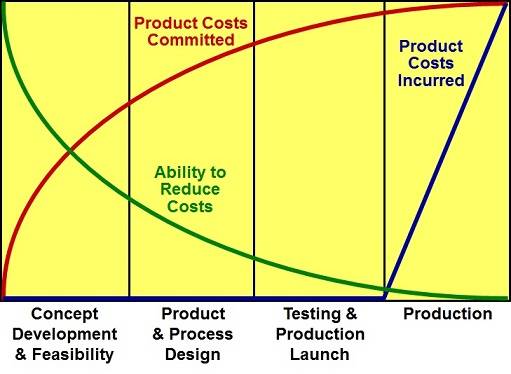Innovation Corner
Permanent link for Fail fast on September 8, 2023
Much of my career has been spent developing new technologies and new products. One of the smartest people I ever worked for, a brilliant scientist, introduced me to the concept of "fail fast."
Up to that point, my approach had been mainly about trying different inventive ideas and seeing what worked. As a team, we would try to figure out what we did right, replicate that, and introduce the next Good Idea.
We had some good ideas. We also had lots of failures. Some of those failures were avoidable and many of them overshadowed the successes. Failure can be expensive.
The flexibility to make changes to a product or service decreases as we get closer to launching in the market. Decisions made earlier in the process become harder and more expensive to change. At the same time, as we approach commercial launch, we're spending more money on development and to acquire goods needed for launch. Potential failure points in our product or service design therefore become more expensive to fix as we get closer to launch. Figuring out why the good parts of an idea work doesn't make for more success, but finding failure points does.
The failing fast mindset accepts that while no idea is perfect, most ideas have merit with some weaknesses. In failing fast, we seek to exploit those weaknesses early in order to identify and either eliminate or mitigate them as early and as cheaply as possible. Instead of testing to verify possible success, test to find potential failure points.
Put another way: we want to learn as fast as possible. Fail fast means to deliberately test for failure points so that we can learn about and eliminate defects in our product, our service, and our business model.
To set up testing, identify the specific hypothesis you want to test. Then, create a test plan that outlines the steps you will take to test the hypothesis. For example, if you want to test whether a new website design will increase conversion rates, you might create two versions of the website with different designs and send half of the traffic to each version. Use A/B testing to measure the conversion rate for each version and use the results to identify which version performed better.
By adopting a fail-fast approach, entrepreneurs can quickly identify mistakes, learn from them, and make improvements. Remember, failure is not something to be afraid of. Instead, it should be embraced as an opportunity to learn and grow.
When developing new products or services, the costs spent on development increases, while the flexibility in making changes to the design of the product or service decreases. Image from NPD Solutions.
Categories:
entrepreneurship
innovation
invention
Posted
by
Thomas Hopper
on
Permanent link for Fail fast on September 8, 2023.


